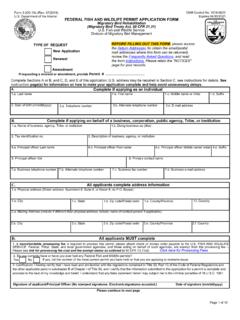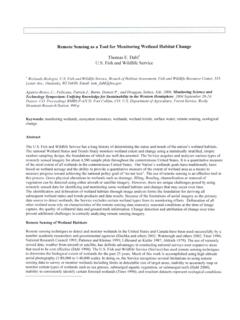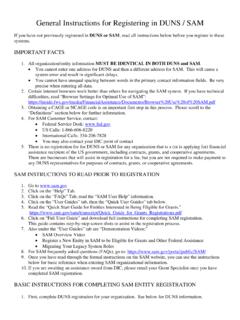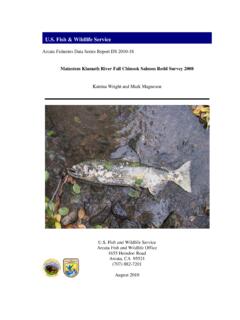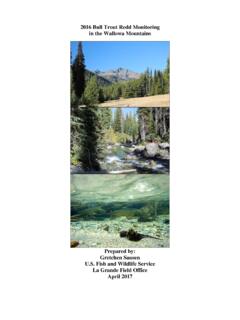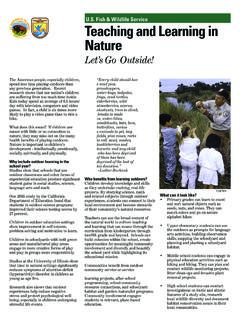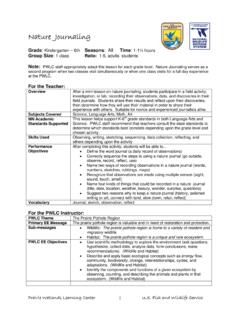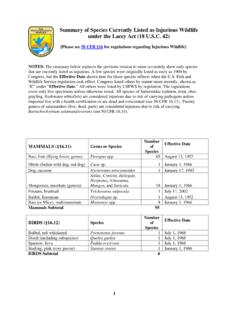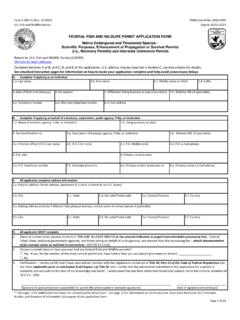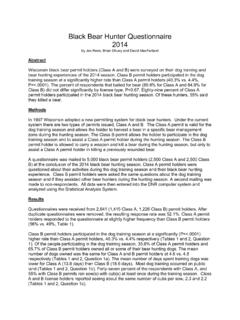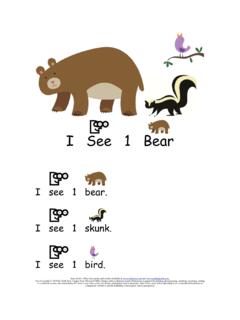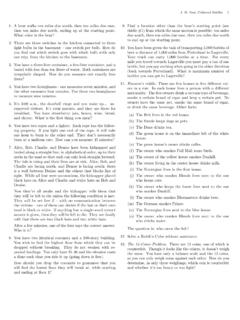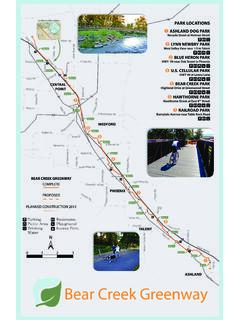Transcription of COMPARISON OF BLACK BEAR PAWS TO HUMAN HANDS …
1 COMPARISON of bear Paws to HUMAN HANDS and Feet p. 1 of 5 Identification Guides for Wildlife Law Enforcement No. 11 Citation: Sims, 2007. COMPARISON of BLACK bear Paws to HUMAN HANDS and Feet. Identification Guides for Wildlife Law Enforcement No. 11. USFWS, National Fish and Wildlife Forensics Laboratory, Ashland, OR. COMPARISON OF BLACK bear PAWS TO HUMAN HANDS AND FEET Identification Guides for Wildlife Law Enforcement No. 11 Margaret Cookie Elizabeth Sims National Fish and Wildlife Forensics Laboratory 1490 East Main Street Ashland, OR 97520 Email: June 2007 Partial wildlife remains found out of context cause much concern over the possibility that the unidentified remains may be of HUMAN origin.
2 Wildlife forensic scientists are often asked to identify unearthed bones found near HUMAN activity areas, such as new home construction, excavation sites, etc. (See Figures 1 and 2.) There have even been cases involving skinned bear paws that had been deliberately placed in public areas to startle those who mistaken them as HUMAN HANDS . Gilbert (1993) suggests that paw bones discarded at taxidermy dump sites could also be confused with HUMAN remains. Because bear paws and HUMAN HANDS and feet are similar in overall size and shape (Figure 3), morphological examination of the skeletal elements are required to enable forensic scientists to identify partial remains in cases where the skin and/or claws are absent.
3 The illustrations used here provide specific characters that can be used to differentiate between bear paws and HUMAN HANDS and feet. Figures 3 and 4 compare bear paw bones (without claws) and HUMAN hand bones. Figures 5 and 6 depict these features as seen with x-ray. Although access to x-ray machines for analysis can be limited for field investigators (package scanners may work in a pinch), radiographs often prove useful in visualizing osteological features on specimens that still retain soft tissue. More information on bear / HUMAN skeletal comparisons can be found in the literature including Walker s Wildlife Forensic Field Manual, which includes additional COMPARISON to mountain lion (see also Orcholl and Hudson 2001, Gilbert 1993, Hillier and Bell 2007, Hoffman 1984, Klepinger 2006, Owsley and Mann 1990, Stewart 1959).
4 Differentiation between species involves visual macroscopic examination of the overall shape and configuration of the skeletal elements and articulating surfaces (joints). The project required use of morphological standards of Ursus americanus (North American BLACK bear ) and Homo sapiens hand and foot bones as comparative reference materials and was conducted at the National Fish and Wildlife Forensic Laboratory (NFWFL) in Ashland, Oregon. Photos by NFWFL unless noted otherwise. COMPARISON of bear Paws to HUMAN HANDS and Feet p. 2 of 5 Identification Guides for Wildlife Law Enforcement No. 11 Figure 1. Skinned bear paw exhibits finger-like HUMAN features.
5 Photo by Constable Timothy Anderson, Alexis Creek Detachment Royal Canadian Mounted Police (British Columbia). Figure 2. Skinned bear paw ( palm up, terminal phalanges/claws removed) that could easily be confused with HUMAN remains. Note similar size to HUMAN hand pictured, and the diagnostic deep grooves that identify the distal ends of bear phalanges. HUMAN fingers (excluding thumbs) have three bones (phalanges) in each finger beyond the palm. The remains pictured here have two (a hint that bear claws have been removed.) Photo by Constable Timothy Anderson, Alexis Creek Detachment Royal Canadian Mounted Police (British Columbia). COMPARISON of bear Paws to HUMAN HANDS and Feet p.
6 3 of 5 Identification Guides for Wildlife Law Enforcement No. 11 Figure 3. Left: skeletal elements of left HUMAN hand (Homo sapiens, palm up). Note terminal phalanges, labeled as phalanx 3, are present (third finger tip bones farthest from long palm bones shown joined with wire). Right: BLACK bear paw (Ursus americanus, front left), shown without terminal phalanges/claws (except digit IV) to illustrate similarity in appearance with HUMAN . Insets: see Figure 4 for close-up view. 3 2 1 3 2 1 1 1 2 2 Figure 4. Insets from Figure 3. Left: HUMAN phalanges showing slightly depressed shape of articular surface of first phalanx. Right: BLACK bear phalanges showing deep V-shaped groove of first phalanx, also clearly visible in the bear remains depicted in Figure 2.
7 COMPARISON of bear Paws to HUMAN HANDS and Feet p. 4 of 5 Identification Guides for Wildlife Law Enforcement No. 11 Figure 5. Left: X-ray of left HUMAN hand showing relatively smooth flat shape of articular surface of first phalanx. Right: X-ray of left front BLACK bear paw showing deep V-shaped groove of first phalanx Figure 6. Left: X-ray of left HUMAN foot showing relatively smooth flat shape of articular surface of first phalanx. Right: X-ray of left rear BLACK bear paw showing deep V-shaped groove of first phalanx COMPARISON of bear Paws to HUMAN HANDS and Feet p. 5 of 5 Identification Guides for Wildlife Law Enforcement No. 11 References: Diagnostic Criteria for the COMPARISON of HUMAN and American BLACK bear Skeletal Elements.
8 Jackie L. Orcholl and Dr. Jean Hudson. 2001. University of Wisconsin Milwaukee. June 13, 2007. < >. Gilbert, 1993. Mammalian Osteology. Columbia: Missouri Archaeological Society. Laramie, WY. Hillier, , and Bell. 2007. Differentiating HUMAN bone from animal bone: a review of histological methods. Journal of Forensic Sciences 52(2):249-263. Hoffman, J. Michael. 1984. Identification of Nonskeletonized bear Paws and HUMAN Feet, in HUMAN Identification: Case Studies in Forensic Anthropology, edited by T. A. Rathbun and J. E. Buikstra, pp. 96-106. Springfield: C. C. Thomas Publisher. Klepinger, Linda L. 2006. Fundamentals of Forensic Anthropology. John Wiley & Sons, Inc. Owsley, , and Mann.
9 1990. Medicolegal case involving a bear paw. Journal of the American Podiatric Medical Association 80(11):623-625. Stewart, 1959. bear paw remains closely resemble HUMAN bones. FBI Law Enforcement Bulletin 28(11):18-22. Walker, Danny N. and William J. Adrian. 2003. Wildlife Forensic Field Manual, 3rd Edition. Association of Midwest Fish and Game Law Enforcement Officers, p 219-221.
